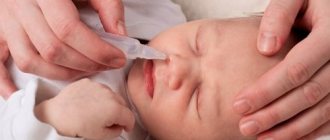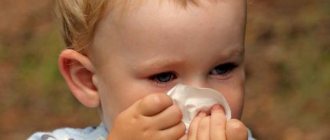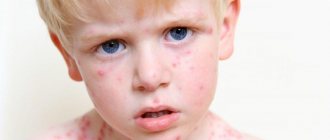Laryngotracheitis belongs to the group of infectious and inflammatory diseases (develops as a result of viruses and bacteria entering the body). The pathology is characterized by the penetration of the pathogen into the tissues of the larynx and trachea.
The disease is more often diagnosed in children under 6 years of age, since they have a relatively short length of the respiratory tract, and also because these organs are not formalized (registration ends by the age of 7). It is important for parents to know the symptoms of laryngotracheitis, as the disease can be fatal if left untreated.
Causes of laryngotracheitis in children and risk factors
The main reason for the development of laryngotracheitis is the entry of the pathogen into the larynx and trachea.
Laryngotracheitis: symptoms and treatment
Infection may occur as a result of:
- development of complications after ARVI (more often observed after influenza or adenoviral infection);
- the presence of a bacterial infection in the body (tuberculosis, scarlet fever);
- allergic reaction affecting the respiratory organs;
- infectious diseases of the upper respiratory tract (rhinitis, adenoiditis).
Laryngotracheitis often develops in children at risk or in the presence of provoking factors:
- weakened immune system (protracted, severe recent infectious disease, radiation or chemotherapy for oncology, chronic pathologies);
- avitaminosis;
- frequent colds;
- living in an area with poor ecology;
- high level of dust and gas contamination in the air;
- bronchial asthma;
- increased load on the larynx due to loud singing or shouting;
- inhalation of tobacco smoke as a result of passive smoking;
- hypothermia of the legs or the whole body;
- violation of breathing through the nose (curvature or fracture of the nasal septum, the presence of a foreign body in the nose);
- severely narrowed lumen in the trachea or larynx due to individual characteristics;
- prolonged inhalation of cold, dry or hot air.
The most important provoking factor is children under 7 years of age, when the larynx and trachea are still fully formed.
Causes
The main cause of laryngotracheitis in children is considered to be a viral infection. By irritating the tissues of the nasopharynx, larynx and the beginning of the trachea, the pathogenic agent creates a typical picture of malaise.
The culprits behind the appearance of the pathogen are varied:
- influenza, ARVI, enterovirus, adenovirus;
- inflammatory processes in the nasopharynx (sinusitis, sinusitis, rhinitis);
- hypothermia;
- damage to the upper respiratory tract (sore throat, pharyngitis);
- allergic reactions.
Dr. Komarovsky believes that, in addition to the factors discussed, an unfavorable living environment can provoke laryngotracheitis in children:
- dry, dusty or polluted air;
- child inhaling tobacco smoke;
- contact with household chemicals.
Chronic laryngotracheitis in children occurs as a consequence of long-term acute inflammation of the larynx and nasopharynx.
Forms of the disease
Laryngotracheitis (symptoms and treatment in children depend on the form of pathology) is divided according to 4 criteria:
| Conditional criteria | Forms of laryngotracheitis | Peculiarities |
| By type of pathogen | Allergic. The pathology is caused by an allergic reaction of the body. Viral. Laryngotracheitis can be either a complication from viral diseases or occur as a result of severe hypothermia (due to a runny nose, severe cough). | The disease is not contagious and can occur in both chronic and acute forms. |
| Bacterial. The disease is caused by the development of complications from diseases of a bacterial nature. | The pathology is contagious. More often it occurs in an acute form. | |
| Viral. Laryngotracheitis can be either a complication from viral diseases or occur as a result of severe hypothermia (due to a runny nose, severe cough). | The disease can be either contagious or caused by provoking factors. It can occur in any form. | |
| According to the speed of manifestation of symptoms from the onset of the disease | Sudden. Laryngotracheitis develops abruptly and as an independent disease (due to hypothermia, lack of immunity). | The infection enters the body as a result of a severe weakening of the immune system and the presence of provoking factors. |
| Spicy. Symptoms appear abruptly against the background of the presence of an infectious disease. | The development of the disease is caused by improper treatment (or lack thereof) of infectious diseases. | |
| Gradual. Signs of the disease appear gradually. Pathology can be caused by a complication or begin to develop independently. | Pathology in this form most often occurs in people with weakened immune systems, as a result the symptoms are mild. | |
| According to the speed of the disease | Spicy. The disease develops quickly with vivid symptoms. The duration of the disease is no more than 14 days. | Laryngotracheitis can develop independently or be a complication of an infectious disease. |
| Chronic. Signs of the disease may wax and wane. The pathology may be present for years. | The disease is often a symptom of chronic respiratory diseases or allergies. | |
| According to the severity of damage to the respiratory mucosa | Catarrhal. It is expressed by redness and the development of slight swelling in the larynx and trachea. | Manifests itself at the initial stage of development of the disease. |
| Atrophic. Tissue atrophy occurs in these organs and disruption of protective functions occurs. | May be present in smokers and people who inhale polluted air. | |
| Hyperplastic. Manifested by the proliferation of connective tissues in the larynx and trachea. It can turn into an oncological form. | More often develops in the chronic form of the disease. |
It is impossible to make an accurate diagnosis and select appropriate treatment on your own. It is important to undergo timely examination and therapy to avoid the development of complications.
Types of laryngotracheitis
Most often, the disease can manifest itself in two forms: acute without complications and complicated. Treatment methods practically do not depend on the form of the disease. But the second form always requires more radical measures and, most likely, the pediatrician will recommend hospital treatment.
Symptoms of acute laryngotracheitis:
- dry, barking cough;
- hoarse voice;
- pain in the chest when coughing;
- the cough has a paroxysmal character;
- sputum production when coughing;
- sputum may become purulent;
- high body temperature.
Symptoms of a complicated disease:
- noisy, difficult breathing;
- severe shortness of breath;
- cardiopalmus.
Acute laryngeal stenosis is otherwise called false croup. The disease is called false because of the similarity of symptoms with true croup that develops with diphtheria. False croup develops as a consequence of influenza, measles, whooping cough, and adenovirus.
The bacterial form of the disease is much less common, but it is much more difficult in infants. Bacteria that cause false croup include: tonsillitis, rhinitis, adenoiditis. Infants with a predisposition to allergic reactions are at risk.
Most often, false croup develops in children who have suffered diathesis, rickets or birth trauma. Moreover, according to statistics, girls suffer from this disease much less often than boys.
Symptoms of laryngotracheitis in children
The symptoms of laryngotracheitis in children depend on the form of the disease.
But the onset of the disease is usually characterized by general symptoms:
- increase in temperature indicators. The value depends on the cause of the disease;
- breathing problems;
- increased heart rate due to lack of oxygen;
- cough of various characteristics;
- congestion in the nasal passages, runny nose;
- constant soreness and sore throat;
- hoarseness and change in voice;
- Due to a sore throat, the child refuses to eat.
Symptoms generally worsen at night, which causes sleep disturbance. It is important that if your lips and nasolabial triangle turn blue, you must urgently call an ambulance.
Acute laryngotracheitis
Acute laryngotracheitis is characterized by the following symptoms:
- a sharp increase in temperature, as the disease often develops as a complication of an infectious disease;
- soreness and tickling sensation in the throat;
- The cough is dry, “croaking”, causing pain in the throat and behind the sternum. Present mainly in the morning and night hours;
- cough intensifies when taking a deep breath, inhaling cold air;
- when coughing, a small amount of viscous and thick sputum is released;
- the voice is hoarse with hoarseness;
- dryness and burning in the throat.
Gradually the cough becomes wet. There is yellow-green sputum. Possible enlargement of the cervical lymph nodes.
Chronic laryngotracheitis
Symptoms of chronic laryngotracheitis manifest themselves either as intensification or weakening of symptoms:
- hoarseness in the voice, during long conversations the voice may disappear;
- cough worsens when taking a deep breath or inhaling cold air;
- constant sore throat; when coughing, pain appears behind the sternum.
During the lull of the disease, there is a constant wet cough, with an exacerbation there is an increase in sputum discharge.
Allergic form of the disease
Allergic laryngotracheitis is expressed by the presence of the following symptoms:
- dry barking cough, intensified by contact with an allergen;
- breathing problems;
- soreness and sore throat;
- hoarse voice.
With a large amount of allergen, the temperature may rise to 38 degrees.
Stenosing laryngotracheitis
Stenosing laryngotracheitis is the most dangerous form.
The disease is accompanied by a narrowing of the larynx or trachea, which can lead to the development of suffocation. The disease manifests itself:
- hoarseness and hoarseness of voice;
- loud cough;
- increase in the number of heart contractions;
- frequent shortness of breath, even with little physical exertion;
- noisy inhalations and exhalations.
With severe narrowing of the airways, blue lips, weak breathing and pale skin are noted.
Useful video about acute laryngotracheitis in a child
List of sources:
- Acute laryngotracheitis in children: etiology, pathogenesis, clinical picture, diagnosis, differential diagnosis, treatment. Textbook for students / M. V. Subbotina // Irkutsk. 2008.
- Diagnosis, differential diagnosis and treatment of childhood infections. 2nd edition / Timchenko V. N., Levanovich V. V., Mikhailov I. B. 2007.
- Krup / L. S. Namazova, N. I. Voznesenskaya, A. L. Vertkin // Attending physician. No. 3. 2003.
Share
Emergency care for a child with acute laryngotracheitis
Laryngotracheitis (symptoms and treatment in children are interrelated, since the severity of the symptoms determines the severity of the pathology and appropriate therapy) can lead to suffocation, so it is important for parents to know the sequence of actions in this situation (before the ambulance arrives):
- Parents themselves should calm down, as children, seeing the fear of adults, begin to panic, which causes increased breathing and increased coughing attacks. This provokes increased swelling and a deterioration in the child’s general well-being.
- Sitting the child, preferably on the mother's lap, is additionally reassuring.
- Open all the vents in the house, you can open the windows if the weather permits. If necessary, use a spray bottle to humidify the air.
- Remove the child's outer tight clothing.
- Give the patient an antihistamine. The dosage and type of medication must be age appropriate. This will reduce swelling in the airways.
- Give the patient mineral water without gases or water with soda to drink (1-3 g of soda per 200 ml).
- Instill vasoconstrictor drugs into the nose; they will not only facilitate nasal breathing, but also reduce swelling in the larynx (since the drug enters the respiratory tract in small quantities).
- If you have a nebulizer, let the child breathe with the saline solution. If it is absent, the patient can be allowed to breathe over the steam of hot water.
- If there is no fever, you can rub your feet or take a hot foot bath. This will ensure a rush of blood to the extremities and reduce swelling in the throat.
Since attacks occur mainly at night, you should not disturb the child too much, this can also frighten him.
You can turn on the night light and carry out all the procedures in the room on the bed. The child should be in a sitting position, this makes breathing and procedures easier. It is important that when breathing stops, you need to open the child’s mouth and, using a spoon, press on the root of the tongue, provoking vomiting. This action will cause a reflex expansion of the airways.
Signs of acute laryngotracheitis: you need to know the “enemy” by sight
In an infectious-inflammatory process, manifestations of false croup occur against the background of symptoms of the underlying infection: fever, cough, runny nose, pain, sore throat. Moreover, laryngotracheitis with a viral infection develops either in the first two days of the disease, or on days 3-5, when a bacterial infection occurs.
If false croup is caused by an allergen, it can develop against the background of the child’s general well-being.
Laryngotracheitis is manifested by a triad of main symptoms:
- Hoarseness of voice until it disappears (in severe condition)
- A "barking" cough ( often described as "seal barking" or "crow cawing") is a hallmark of laryngotracheitis
- Shortness of breath ( difficulty for the child to take a breath)
The severity of each of the signs depends on the degree of narrowing of the lumen of the larynx:
First degree (compensated). A dry cough appears, which quickly gives way to a “barking” cough. There is moderate hoarseness and hoarseness of the voice, which increases with crying. Also, during exertion (for example, during a game), noisy and moderately rapid breathing appears, which is characterized by difficulty breathing (inspiratory dyspnea). Whereas at rest the baby breathes calmly.
Second stage (partial compensation). The child is scared and restless. Breathing becomes noisy and audible at a distance (has a “sawing” character). Shortness of breath intensifies, and during breathing the wings of the nose moderately inflate, and the skin above the sternum and between the ribs is slightly retracted. The skin around the lips and fingertips turns blue - signs of lack of oxygen.
There is pronounced hoarseness of the voice even at rest. Periodically, a “barking” cough may change to an intrusive and rough one. Moreover, the signs can be either constant or appear intermittently.
Third stage (uncompensated). The child's anxiety and intimidation are replaced by periods of lethargy. Shortness of breath is constant and severe: the skin above and below the sternum is sharply retracted, as well as between the ribs. At the same time, the skin becomes covered with cold sweat and becomes pale.
At rest there is pronounced hoarseness of voice. At first, the cough is rough and loud, then, as the lumen of the larynx narrows, it becomes somewhat quieter.
Fourth stage. The child loses consciousness, and breathing becomes shallow, frequent and irregular.
Moreover, in practice there is often no clear line between the degrees. In addition, if the general condition worsens over several hours, the larynx can quickly narrow, leading to the development of a life-threatening condition: an attack of suffocation.
Therefore, there are indications for calling an ambulance without waiting for the child’s well-being to worsen:
- Severe hoarseness of voice at rest
- Blue skin around lips and fingertips
- Moderate flaring of the wings of the nose, as well as retraction of the skin between the ribs and above the sternum
- The appearance of shortness of breath and noisy breathing at rest
- Baby is scared and restless
- A “barking” cough periodically changes to a rough and intrusive cough
However, in order to prevent the development of an attack of suffocation, it is better to consult a doctor at the first symptoms of laryngotracheitis.
Diagnosis of the disease
Diagnosis of laryngotracheitis is made by a pediatrician or otolaryngologist in stages:
- Collecting information from the patient: what symptoms are present besides a “barking” cough and breathing problems;
- what factors preceded the development of the disease (ARVI, hypothermia, contact with an allergen);
- is there a predisposition to allergies;
- when symptoms get worse.
- X-ray of the larynx and trochea;
If the development of cancer is suspected, material is collected for oncotests. When diagnosing, it is necessary not only to exclude diseases with similar symptoms (asthma, bronchitis, foreign body stuck in the respiratory tract), but also to identify the type of pathogen to accurately determine the appropriate drugs.
Disease prevention
Any disease is more difficult to treat than to prevent. Of course, more often the tendency to false croup largely depends on the individual characteristics of the body. And if a child has a cold or is suffering from a viral disease, special attention must be paid to the larynx and respiratory tract.
For prevention, you can periodically ventilate the room and maintain air humidity. And the most important thing is to harden your throat. Rinsing is suitable for this. Initially, you need to use warm water and gradually lower its temperature. There should not be a sharp change in temperature (it is better to maintain it at the same level every 3 days), this will only harm the child’s body.
During walks, make sure that the baby is comfortable, especially for babies in the first month of life. If it’s summer, then you don’t need to wrap the baby in clothes, he shouldn’t be hot, and in winter he should definitely avoid hypothermia. Disease prevention requires special attention in the autumn and spring seasons.
Treatment methods for laryngotracheitis in children
When diagnosing laryngotracheitis, specialists use the following treatment methods:
- try to provide vocal and psychological peace to the child in order to reduce the load on the respiratory tract;
- the air in the room should be within 18-20 degrees and sufficiently humidified;
- compliance with diet therapy. The child must receive enough nutrients. Food should not irritate the larynx and trachea;
- it is necessary to provide the patient with sufficient fluids to moisturize the larynx and trachea, thin the sputum and accelerate the removal of toxins from the body;
- taking appropriate medications (antiviral, antihistamine or antibacterial drugs);
- physiotherapy;
- inhalation.
Additional treatment with folk remedies is carried out with the permission of the pediatrician. Full compliance with the doctor’s recommendations will avoid the development of complications.
In severe forms of the disease, treatment is carried out inpatiently. According to Dr. Komarovsky, antibiotics should be avoided. You can improve breathing and destroy the pathogen by taking antitussive and immunomodulatory drugs. This will cause less harm to the child’s body.
Self-treatment
When treating this disease, the parents' ability to help their child is very limited. The main treatment should be prescribed and monitored by a doctor.
To make breathing easier for your child, you can do the following procedure:
- Add 3-4 ml of water to 0.4 ml of naphthyzin (take a 0.05% solution);
- Sit the child down and tilt his head back slightly;
- Inject the solution into the nostril with a syringe without a needle. The fluid must be administered quickly.
If after these actions the baby coughs, then everything has been done correctly and breathing will become easier. The procedure can only be performed once.
In the acute form of the disease, you can give the child an antihistamine, this also helps improve breathing.
While waiting for qualified specialists, parents can alleviate the child’s condition. First, you need to lay it on a bed or sofa with a pillow under the backrest. If possible, you should try to humidify the air in the room and free the baby from tight clothes.
Difficulty breathing with laryngotracheitis is caused by the accumulation of sputum in the larynx. To make this phlegm thinner, you can give your child a warm drink with soda or Borjomi. If breathing stops, induce vomiting.
If your child has a high temperature or a fever, an antipyretic drug will help.
Drug therapy according to age and form of the disease
Laryngotracheitis requires drug treatment, since in children the disease is dangerous for the development of severe complications. When choosing a drug, a pediatrician or otolaryngologist takes into account the child’s age and severity of the disease, symptoms and diagnostic results.
| Child's age | Forms of laryngotracheitis | ||
| Allergic | Viral | Bacterial | |
| 0-12 months |
|
|
|
| 1-3 years |
|
|
|
| 3-7 years |
|
|
|
| After 7 years |
|
|
|
To eliminate swelling in the respiratory tract, with viral and bacterial laryngotracheitis, it is additionally recommended to take antihistamines.
Why does laryngotracheitis occur?
Laryngotracheitis in a child is inflammation and swelling of the mucous membrane of the larynx and the initial parts of the trachea. This disease most often occurs in children from 3 months to 6 years (in most cases in children from one to three years). The main provoking factor in the development of laryngotracheitis is considered to be a decrease in the reactivity of the immune system - both local and general immunity.
The trigger point of the disease is most often viral infections (parainfluenza, adenoviral and rhino-syncytial infection, influenza), and acute inflammation caused by viruses against the background of an immature or weakened immune system is complicated by the layering of bacterial flora (pneumococci, staphylococci, streptococci and other microorganisms). The inflammatory process becomes more aggressive and, in addition to the nasopharynx, affects other organs of the respiratory system - the larynx and trachea.
In addition to viral infections, acute laryngotracheitis can be caused by:
allergic reactions; hypothermia; overstrain of the vocal cords (loud talking, screaming, singing); stress.
Parents should know that acute laryngotracheitis in children is a dangerous disease that can be complicated by laryngeal stenosis and swelling of the vocal cords with the occurrence of false croup syndrome (“barking” cough, shortness of breath, whistling when breathing).
Therefore, if characteristic symptoms of the disease appear in a young child, it is necessary to urgently seek medical help and treat the baby with the prescribed methods.
Folk remedies for laryngotracheitis
Laryngotracheitis (symptoms and treatment in children depend on the stage of development of the disease) can be eliminated using folk remedies. In mild cases of pathology or as a preventative measure, folk formulations can be used as independent therapy. For moderate and advanced types of the disease, complex treatment is required. A doctor's consultation is required.
Rules for the preparation and use of folk remedies:
| Dosage form of folk compositions | Components used | Features of application |
| Herbal mixtures for oral administration | A mixture of coltsfoot and oregano (15 g), chamomile flowers (15 g) and 250 ml of boiling water. | Steam the herbs in boiling water. Leave for 30 minutes. strain. Drink during the day in 3-4 doses. |
| Combine licorice root, fennel and coltsfoot in equal proportions. You will need 20 g of collection and 300 ml of boiling water. | Steam the collection and leave for 30 minutes. Divide the infusion into 4 doses and drink throughout the day. | |
| Juices and syrups for oral consumption | Freshly squeezed carrot juice (200 ml), honey (30 ml). | The juice needs to be slightly warmed and honey dissolved in it. Take 10-20 ml 5 times a day. |
| Onion, granulated sugar (50 g), warm water (200 ml). | Place sugar and chopped onion in water. Simmer on fire for 10-15 minutes. Take 10-15 ml 4 times a day. | |
| Figs (4-5 fruits), milk (200 ml) | Pour hot milk into a thermos and place figs there. Leave for 8 hours. Take 50 ml 3 times a day. | |
| Infusions and decoctions for rinsing | Sea salt (3 g) and warm water (200 ml). | Combine the ingredients and mix thoroughly. The salt should dissolve completely. Rinse not 3 times a day. |
| Soda (3 g), warm water (150 ml) and juice from 1 potato. | Combine ingredients, mix well. Gargle 3-4 times a day. Use fresh solution each time. | |
| Infusions and solutions for inhalation | Baking soda (3 g) and drinking water (200 ml). | Connect the components. The solution is used for inhalation using a nebulizer. |
| Potatoes and eucalyptus oil (2-3 drops) | The potatoes need to be boiled (do not remove from the broth), add eucalyptus oil. Breathe above the steam (you don’t need to cover yourself with a towel). Carry out procedures 2-3 times a day. Definitely before going to bed. |
When treating with folk compounds, it is important to monitor the child’s reaction, since the drugs can cause an allergic reaction and worsen the patient’s condition. It is important that up to a year, all folk formulations are used extremely carefully and only with the permission of the pediatrician.
Treatment
If a child turns pale during a coughing attack, begins to choke, has convulsions and foamy discharge from the mouth, it is necessary to urgently call an ambulance and send the child to the hospital.
If the situation is not so serious, treatment of laryngotracheitis at home is allowed. In this case, parents should pay special attention to the following points:
- Maintaining a favorable microclimate in the room where the child is. The room should be regularly ventilated, the air temperature should not exceed 20–23 °C, and humidity should be within 55–60%.
- Compliance with drinking regime. With laryngotracheitis, the baby needs warm, plenty of fluids. Moisturized vocal cords cope better with damage and recover faster. It is recommended to consume herbs (chamomile, sage, coltsfoot), unsweetened fruit drinks, milk with mineral water.
- Proper nutrition. Damaged laryngeal mucosa requires soft, warm, preferably crushed food.
During the treatment of laryngotracheitis, the child should talk less and should not scream or cry. Silence speeds up tissue healing and speeds up recovery.
Medicines for laryngotracheitis in a child
To eliminate the symptoms of laryngotracheitis, the child is prescribed the following medications:
- antipyretic and anti-inflammatory - Ibuprofen, Paracetamol;
- antihistamines - Desloratadine, Erespal, Tavegil, Erispius syrup, Fenistil;
- corticosteroids - Dexamethasone, Prednisolone.
Cofex and Codterpin will help your child get rid of a painful night cough. Among herbal remedies, Glaucine hydrochloride has a good effect. Mukaltin, Alteyka syrup, Prospan, Gederin, Tussin will cope with dry cough.
With proper treatment, a nonproductive cough quickly turns into a wet cough, breathing normalizes and well-being improves. The child becomes more active and has an appetite. To liquefy and quickly remove sputum, Lazolvan, ACC, Ambrobene, Ambroxol are prescribed.
Antibacterial drugs for laryngotracheitis in children are most often not needed, since the disease in 90% of cases is viral in nature. But if the need for antimicrobial agents does arise, they are used only as prescribed by a doctor.
Traditional methods of treating laryngotracheitis in a child
Sometimes alternative treatment methods help no worse than those recommended by official medicine.
Radish juice with honey is considered an effective way to treat coughs with laryngotracheitis. The juicy vegetable is washed and the top is cut off, then part of the pulp is removed. Liquid honey is poured inside and put in a warm place. A day later the medicine is ready. Sweet juice is given to the child three times a day, 1 tsp.
Warm onion broth is good for sore throats. The onion is peeled, finely chopped and mixed with 2 tbsp. l. sugar and 200 ml water. The mixture is placed on low heat and kept until thickened. Give to the baby 4 times a day after meals.
Rinse for laryngotracheitis in a child
Another great way to cope with laryngotracheitis in a child at home. Frequent irrigation of the throat (6–8 times a day) relieves inflammation, reduces swelling and irritation.
The following products are recommended for rinsing:
- a solution of sea or regular table salt (7 grams per ½ liter);
- fresh beet juice diluted with water;
- infusions of herbs (chamomile, linden, eucalyptus, birch leaf);
- warm potato broth.
At night, it is good to give your child a glass of hot milk with honey and butter or boiled dates.
Inhalations for laryngotracheitis in a child
A simple and effective way to treat laryngotracheitis in young children. The procedure does not require any skills from the child or effort from the parents. It is enough to purchase a nebulizer and pour the medicinal solution into it. Mineral water like Essentuki, herbal decoction or children's cough syrups (Prospan) are perfect for this. But Berodual should not be used for laryngotracheitis. This medication has completely different indications.
If the child is over 5 years old, you can use a bowl of hot infusion of medicinal plants or a solution of pharmaceutical preparations for inhalation. The procedure should be carried out only in the presence of adult family members.
A good effect for laryngotracheitis is provided by hot foot baths or mustard plasters on the calves. Warm compresses on the throat and irradiation with a UV lamp are still relevant.
How long does laryngotracheitis last in children? With proper and timely treatment, the disease goes away in 10–14 days. After 3–4 days of active therapy, the temperature decreases and the child’s well-being improves, then the dry cough becomes productive and the voice is restored.
If symptoms persist for more than 2 weeks, everything indicates the development of a chronic form of the disease.
Inhalations using drugs
The most effective treatment for laryngotracheitis is the use of inhalation drugs. The drugs can quickly ease breathing during exacerbation of the disease.
The following medications are recommended for the nebulizer:
- Berodual. The drug is available not only in the form of a solution for inhalation, but also in the form of an inhaler. Which is convenient to use when outside the home. There are no age restrictions;
- Saline solution. Can only be used for inhalation using a nebulizer. There are also no age restrictions;
- Pulmicort. The powder and solution are used for inhalation using a nebulizer. In childhood, it is used under the supervision of a pediatrician, as the drug can cause growth retardation.
The dosage of the drug and the time of inhalation are selected individually according to age and severity of the disease. Independent adjustment of the course of therapy is prohibited.
Causes and symptoms
Often, laryngotracheitis is caused by a viral infection (parainfluenza, influenza, herpes). Among the main reasons contributing to the occurrence and development of the disease are:
features of the anatomical and physiological structure of the nasopharynx organs under the age of five years (narrow larynx); colds; weakened immune system; hypothermia, often a small draft is enough; contact with a carrier of infection; loud and prolonged scream, overstrain of the vocal cords, mechanical damage to the larynx; inhalation of various substances that cause allergies (varnish, paint, wool, dust); high temperature (above 22 degrees), low humidity (less than 50%) and dusty air in the room where the patient is.
The likelihood of laryngotracheitis increases in the presence of chronic diseases of the nasopharynx, frequent nasal congestion, diseases of the teeth and gums.
Also, under the age of five years, the disease is often accompanied by signs of false croup, which is dangerous due to severe swelling of the pharynx and can cause suffocation. Therefore, in order to prevent a threat to the child’s life, you should know what symptoms appear with laryngotracheitis, and what treatment is required at different stages of the development of the disease.
There are several forms of the disease, each of which is characterized by certain symptoms and requires an individual approach:
Catarrhal form is the safest type of laryngotracheitis. It is this form that most often occurs under the age of fourteen. The main symptoms of laryngotracheitis in this case are similar to the signs of most viral infections: sore throat, hoarseness, dry annoying cough, hyperthermia. However, if treated incorrectly or untimely, there is a high probability of developing stenosis, which is life-threatening. The hyperplastic form is a type of laryngotracheitis, which also often develops in children. The main difference between this form is the severe swelling of the pharyngeal mucosa, which can cause difficulty breathing. The hemorrhagic form is accompanied by hemorrhage into the laryngeal mucosa and often occurs due to the presence of certain provoking factors (disorders of the hematopoietic process, liver disease). The main signs in this case: dry mouth, attacks of suffocating cough, viscous secretion mixed with blood, sensation of a foreign object in the throat.
Laryngotracheitis is diagnosed in 30% of children under three years of age who first encountered a common respiratory viral infection. The risk of developing the disease is higher in those who suffer from allergies.
The main symptoms and signs of laryngotracheitis, which appear at any stage of the disease:
runny nose, hyperthermia, general weakness are the main signs of acute respiratory disease; change in voice timbre, hoarseness; sore throat when swallowing; decreased appetite; dry, paroxysmal, barking cough; rapid or, on the contrary, difficulty breathing; dyspnea; in later stages of the disease, against the background of difficulty breathing, paleness of the skin and cyanosis of the nasolabial triangle may appear.
Important! If an infant falls ill with laryngotracheitis, the following signs will help diagnose the disease: lethargy, increased anxiety, moodiness, runny nose, loud, barking cough.
Diet therapy
During the treatment period, it is important to adhere to diet therapy:
- food should be warm. Hot or cold food will irritate the respiratory tract;
- fatty, spicy and salty foods are excluded, as they place excessive stress on the digestive tract and contribute to moisture retention in the body;
- The daily diet should consist of small portions. The frequency of meals is 5-6 times a day;
- the diet should be varied. Products must contain a sufficient amount of nutrients (broths, liquid porridges with pieces of soft fruit, pureed soups);
- exclude allergy-containing products from the menu.
You must drink at least 2 liters of liquid per day. Preferably juices, compotes and jelly.
Prevention
In the prevention of any damage to the respiratory tract, including laryngotracheitis, hardening the body and maintaining a healthy lifestyle play a huge role.
It means:
- A balanced diet with plenty of vitamins and a minimum of sweets and baked goods.
- Age-appropriate physical activity. The child should be outside as much as possible, play outdoor games or just take a walk.
- Strict daily routine. A clear routine preserves vitality and calms the child, maintaining the body's resistance.
It is also necessary to prevent viral infections, timely vaccinate the baby, and avoid communication with sick people.
Physiotherapy
If laryngotracheitis occurs without an increase in temperature, then the doctor (in combination with drug therapy) prescribes physiotherapeutic procedures:
- UHF therapy. The therapeutic effect on the body is a high-frequency electromagnetic field;
- magnetotherapy. The procedure is performed on the laryngeal area;
- electrophoresis. Medicines are administered through the skin under the influence of a weak electric current;
- short ultraviolet radiation of the laryngeal mucosa.
At home, you can perform light massages, which consist of gentle pats on the back (the child is in a lying position). This allows mucus to leave the lungs more efficiently. Additionally, it is recommended to visit medical sanatoriums once a year.
Prevention methods
Measures to prevent laryngotracheitis involve, mainly, a natural improvement in the body’s protective functions:
The child should spend more time outdoors; the child’s body should experience moderate daily physical activity; It’s good to go on vacation to the sea once a year; vegetables, fruits, and nuts should be included in the diet.
What to avoid
Hypothermia is a sure way to reduce immunity; staying in kindergarten during seasonal peaks of ARVI; smoking in the presence of a child.
Under what conditions is laryngotracheitis diagnosed? The answer is given by Dr. Komarovsky.
Daily regimen for children with laryngotracheitis
Laryngotracheitis (it is important to discuss symptoms and treatment in children with a pediatrician; self-diagnosis and self-medication can be fatal for the child) can be treated more successfully if you follow the doctor’s recommendations for a home regimen:
- daily ventilation and humidification of indoor air;
- observe the temperature regime, not only indoors, but also dress the child according to the weather;
- take daily walks, preferably in forested areas (if there is no temperature);
- exclude the child from being in smoking areas;
- the patient must get enough sleep. Therefore, it is important to give your child proper rest not only at night, but also during the daytime.
In the presence of any colds (even with a common runny nose), timely treatment is required, otherwise the disease may develop into a complication in the form of laryngotracheitis.
Why does laryngotracheitis occur?
A key factor in airway inflammation is a decrease in local immunity. As shown above, it can be caused by viruses. But often the cause of laryngotracheitis in children is non-viral.
Bacterial laryngotracheitis due to decreased local immunity
Various bacteria surround us everywhere: some live on the skin, others are limited in the nose, mouth, and throat. The child's immunity is undeveloped and unstable. Weakened immunity of the upper respiratory tract provides pathogenic microbes with opportunities to spread.
The main factors weakening the immunity of the larynx and trachea:
Hypothermia; inhaling cold air through the mouth (for example, when children play in winter); passive smoking (for example, when adults smoke in a room where children are).
Bacterial laryngotracheitis as a result of infection by pathogenic microbes
To start the inflammatory bacterial process it is necessary:
Imbalance of the microflora of the upper respiratory tract; inability of the immune system to restore the balance of “forces”.
A factor that significantly disrupts the balance of attacking microbes and protective forces is an external source of bacterial infection - a sick person. When coughing and sneezing, pathogenic microorganisms are sprayed into the surrounding space in huge quantities. The child’s body cannot cope with such a bacterial “attack” and becomes ill.
Bacterial laryngotracheitis due to an infectious focus in a child
The source of infection can be not only the external environment and opportunistic microbes inhabiting the upper respiratory tract, but also existing infectious foci in the body:
In the nose (rhinitis); in the paranasal sinuses (sinusitis); inflamed tonsils (tonsillitis); sore throat (pharyngitis).
All of these diseases can lead to the spread of infection down the respiratory tract.
Allergic laryngotracheitis
Swelling of the larynx due to a non-infectious nature. Occurs as an allergic reaction to exposure to, for example, aerosol medications.
Possible complications and prognosis
Laryngotracheitis is dangerous due to the development of suffocation. Therefore, it is important to begin treatment of the disease in a timely manner. If you follow the doctor’s prescriptions and complete the full therapeutic course, the disease can be eliminated. In the absence of proper measures, the pathology becomes chronic and can cause death.
Possible complications from laryngotracheitis are:
- violation of tone and quality of voice (constant hoarseness or hoarseness);
- due to lack of oxygen, the child may lag behind in mental and physical development;
- penetration of infection into the bronchi.
In the chronic form of laryngotracheitis, regular injury to the mucous membranes in the respiratory tract occurs, which can cause the development of benign or malignant formations in the respiratory tract. Laryngotracheitis develops primarily as a complication after untreated infectious diseases or as a result of an allergic reaction.
The disease is most often diagnosed in children from birth to 6 years of age. At this age, it is necessary to approach the choice of medications taking into account age indicators. When prescribing a conditionally approved drug, it is necessary to strictly adhere to the dose and course of treatment. It is important that if left untreated, the disease can be fatal, so parents should know the dangerous symptoms of the disease.
Diagnostics
Diagnosis of laryngotracheitis in a child begins with examining the throat with a spatula and listening to the chest. In difficult cases, direct laryngoscopy or fibrolaryngoscopy is performed, however, if the baby is restless, the value of these manipulations is low.
Photo from the website malutka.pro
Recently, rigid endoscopes are increasingly used to examine the child’s upper respiratory tract. Using optics located at the end of the instrument, pathological changes in the tissues of the larynx and pharynx can be seen with magnification. If necessary, the same device can remove mucus and saliva.
To confirm the diagnosis, the child is prescribed auxiliary studies:
- Ultrasound scanning;
- swabs from the throat and nose;
- rhinoscopy;
- picture of the sinuses;
- allergy tests.
The purpose of all these activities is to identify the cause and form of laryngotracheitis, determine treatment tactics and the need to provide qualified assistance.











